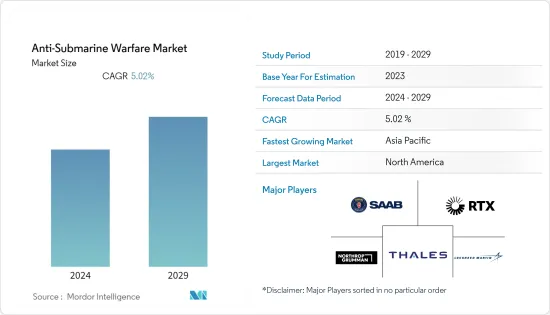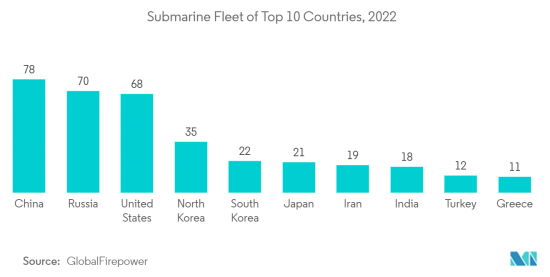
대잠수함전(대잠전) 시장은 2024년에 179억 8,000만 달러로 평가되며, 2029년에는 229억 8,000만 달러로 성장하며, 예측 기간 중 CAGR은 5.02%를 기록할 것으로 예측됩니다.

대잠수함전은 전 세계 해군 부대의 전략적 속도와 작전 민첩성을 지키는 데 필수적입니다. 새로운 기술의 보급이 아군과 적군 모두의 작전 계획과 임무 수행에 극적인 영향을 미치고 있기 때문입니다. 대잠수함전은 수면 아래에서 활동하는 적군의 신속하고 은밀한 공격으로부터 해상 자산을 보호하기 위해 필수적입니다. 스텔스 잠수함 및 무인 해양 시스템과 같은 첨단 해양 기술 개발을 위한 연구개발이 진행되면서 스텔스 잠수함 및 기타 수중 적대적 선박을 탐지할 수 있는 강화된 범위 소나 시스템과 같은 대응 수단 개발에 대한 잠재적 투자를 촉진할 것으로 예상됩니다. 그러나 대잠수함 전투 시스템 개발에 따른 운영의 복잡성과 높은 비용이 시장 성장에 걸림돌이 될 수 있습니다.
잠수함 부문은 심도 변경 능력과 탐지를 돕는 정숙성으로 인해 높은 CAGR로 성장할 것으로 예상됩니다. 미국, 영국, 중국, 인도와 같은 군 강국들은 해군 화력 증강에 주력하고 있으며, 국가 안보에 대한 진화하는 위협에 대응하기 위해 여러 함대 현대화 및 조달 계약이 진행 중입니다. 예를 들어 미 해군은 2022년 12월 제너럴 다이내믹스(General Dynamics)에 51억 달러 규모의 계약을 발주하여 미 해군의 미래 콜롬비아급 잠수함의 핵심 부품의 사전 제작을 진행했습니다. 미 해군은 수명 연장과 신규 건조를 결합하여 2034년까지 355척의 목표를 달성하기 위해 전력 구조 확장 계획을 적극적으로 추진하고 있습니다. 이와 관련, 미 해군은 2021년에 로스앤젤레스급 공격형 잠수함을 인수했습니다. 최근에는 2023년 3월 호주가 미국과 영국의 협력으로 핵잠수함을 건조할 계획을 발표하고 '오크스(Oaks)'라는 협정을 체결했습니다. 전체 프로그램 비용은 2,680억-3,680억 달러로 예측됩니다. 유사한 유도 프로그램이 예측 기간 중 잠수함 부문을 추진할 것으로 예상됩니다.

미국과 아시아태평양 주권국가 간의 전략적 군동맹 강화와 그에 따른 군적 배치 및 군적 개입 강화는 복잡한 시나리오를 가져왔고, 중국과 같은 지역 국가들이 기득권을 지키기 위해 국방력을 빠르게 현대화하도록 유도하고 있습니다. 중국은 육상, 공중, 해상 등 세 가지 플랫폼 모두에서 군력을 강화하기 위해 방대한 기술력을 여러 무기체계의 독자적인 개발에 투자하고 있습니다. 중국은 또한 정찰에서 기뢰 제거, 심지어적 함선에 대한 특공에 이르기까지 다양한 임무를 수행할 수 있는 크고 똑똑하며 비교적 저렴한 비용으로 오래 지속되는 무승무원 잠수함을 개발하고 있습니다. 해양에서의 긴장이 고조되고 있는 상황에서 능력을 연마하기 위한 노력의 일환입니다.
반대로 인도양 지역에서 중국 인민해방군 해군의 관심이 높아짐에 따라 인도 해군은 카모르타급 코르벳 등 대잠수함, 보잉 P-8 포세이돈 등 장거리 해상 정찰기, 서류급 초계함 등 선박에 빠르게 투자하고 있습니다. 호주는 또한 스콜펜급을 기반으로 한 바라쿠다급 잠수함 6척을 도입해 잠수함 함대 증강을 구상하고 있습니다. 이 외에도 여러 가지 계획이 이 지역에서 진행 중이며, 예측 기간 중 주목할 만한 시장 성장 전망을 강화하고 있습니다.
대잠수함전 시장은 세분화되어 있으며, 많은 세계 기업이 시장에 존재하고 있습니다. 시장내 주요 업체로는 Lockheed Martin Corporation, RTX Corporation, Northrop Grumman Corporation, Saab AB, THALES 등이 있습니다. 장기 계약을 체결하고 세계 입지를 확대하기 위해 기업은 새로운 해군 자산을 조달하는 데 많은 투자를 하고 있습니다. 또한 지속적인 연구개발, 파트너십 및 사업 확장은 대잠수함 전투 능력을 갖춘 해군 전투 시스템의 통합 무기 기술 및 관련 제품 및 솔루션의 정확성과 효율성을 향상시키고 있습니다.

The anti-submarine warfare market was valued at USD 17.98 billion in 2024 and is projected to grow to USD 22.98 billion by 2029, registering a CAGR of 5.02% during the forecast period.
Anti-submarine warfare is critical for protecting the strategic speed and operational agility of naval forces around the world, as the proliferation of new technologies is dramatically affecting the operational planning and execution of missions of both friendly and hostile forces. With counter- and anti-denial strategies evolving as a crucial part of implemented maritime strategies of key naval forces, anti-submarine warfare has become vital in protecting maritime assets against a swift, stealthy attack from hostile forces operating below the surface of the water. The ongoing R&D toward the development of advanced maritime technologies, such as stealth submarines and unmanned marine systems, is envisioned to inspire potential investments in developing countermeasures, such as enhanced range-sonar systems, that can detect stealth submarines and other immersed hostile craft. However, operational complexities and high costs involved in the development of anti-submarine warfare systems may pose a challenge to market growth.
The submarines segment is expected to grow at a high CAGR owing to their ability to change depth and their quietness, which aids detection. Military powerhouses, such as the United States, the United Kingdom, China, and India, are focused on augmenting their naval firepower, and several fleet modernization and procurement contracts are underway to address the evolving threats to their national security. For instance, in December 2022, the US Navy awarded a USD 5.1 billion contract to General Dynamics to conduct advanced construction of critical components for the US Navy's future Columbia-class submarines. The US Navy has been actively implementing force structure expansion plans, aiming to reach its 355-ship goal by FY 2034 through a mix of service life extensions and new construction. In this regard, in 2021, the US Navy received a Los Angeles-class attack submarine. Recently, in March 2023, Australia announced its plan to build a nuclear-powered submarine with the help of the US and UK and signed an agreement called the Aukus. The entire program is projected to cost between USD 268-368 billion. Similar induction programs are envisioned to drive the submarine segment during the forecast period.

The strengthening of the strategic military alliances between the United States and several Asia-Pacific sovereign nations and subsequent reinforcement of military deployment and intervention has resulted in a complex scenario, urging rapid modernization of defense capabilities of regional countries, such as China, to safeguard their vested interests. China has invested its vast technological prowess toward the indigenous development of several weapon systems to foster its military prowess over all three platforms- land, air, and water. China is also developing large, smart, and relatively low-cost crewless submarines with long endurance capacity to perform a wide range of missions, from reconnaissance to mine placement to even suicide attacks against enemy vessels. In August 2023, China conducted anti-submarine exercises in the South China Sea as part of efforts to hone its capabilities amid rising maritime tensions with its neighbors and their allies.
On the contrary, the increasing interest of the Chinese People's Liberation Army Navy in the Indian Ocean region has led the Indian Navy to rapidly invest in anti-submarine ships, such as the Kamorta-class corvette, long-range maritime reconnaissance aircraft such as Boeing P-8 Poseidon and ships such as the Saryu-class patrol vessel, among others. Australia also envisions boosting its submarine fleet with the induction of six Barracuda class submarines based on the Scorpene-class. Several other programs are underway in the region, bolstering the growth prospects of the market in focus during the forecast period.
The anti-submarine warfare market is fragmented, with many global players present in the market. Some of the prominent players in the market are Lockheed Martin Corporation, RTX Corporation, Northrop Grumman Corporation, Saab AB, and THALES. In order to gain long-term contracts and expand their global presence, players are investing significantly in the procurement of new naval assets. Furthermore, continuous R&D, partnerships, and expansions are fostering the advancements in accuracy and efficiency of integrated weapon technologies and associated products and solutions of naval combat systems with anti-submarine warfare capabilities. For instance, in April 2021, THALES signed a contract with Lockheed Martin as a tier-one supplier for the delivery of up to 55 airborne anti-submarine warfare sonars. Likewise, in April 2022, Saab announced a new 10,000 sq. ft. Anti-Submarine Warfare (ASW) production facility in Rhode Island, the US. The facility will also house the Autonomous and Undersea Systems Division of Saab AB.